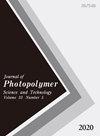菌丝体形成玻璃微通道
IF 0.7
4区 化学
Q4 POLYMER SCIENCE
Journal of Photopolymer Science and Technology
Pub Date : 2021-06-11
DOI:10.2494/photopolymer.34.381
引用次数: 0
摘要
提出了一种制备复杂三维玻璃微通道的新方法。我们利用菌丝体来达到这个目的。菌丝体具有复杂精细的三维网状结构。我们在二氧化硅化合物中培养菌丝体,然后将二氧化硅化合物加热烧结。在加热过程中,所有菌丝体都被烧毁,在透明的玻璃芯片中保留了精细的网状通道结构。我们也试图控制这种菌丝体的生长。生长条件可以改变其生长。在这项工作中,我们为此目的使用了循环机械刺激。我们对生长菌丝下的样品设置循环拉伸应变。这种循环应变在一定条件下引起菌丝的各向异性生长。本文章由计算机程序翻译,如有差异,请以英文原文为准。
Glass Microchannel Formation by Mycelium
We propose a new method to fabricate complicated 3-dimensional glass microchannels. We employed mycelium for this purpose. Mycelium possesses a complicated, fine and three-dimensional network structure. We cultivated mycelium in silica compounds, and subsequently silica compounds were heated to be sintered. During this heating process, all the mycelium was burned off and remained a fine network channel structure in a transparent glass chip. We also tried to control of the growth of this mycelium. The growth could be changed by growth conditions. In this work, we used cyclic mechanical stimuli for this purpose. We set cyclic tensile strain to the sample under growing mycelium. This cyclic strain caused anisotropic growth of the mycelium in some condition.
求助全文
通过发布文献求助,成功后即可免费获取论文全文。
去求助
来源期刊
CiteScore
1.50
自引率
25.00%
发文量
0
审稿时长
4-8 weeks
期刊介绍:
Journal of Photopolymer Science and Technology is devoted to the publication of articles on the scientific progress and the technical development of photopolymers.

 求助内容:
求助内容: 应助结果提醒方式:
应助结果提醒方式:


